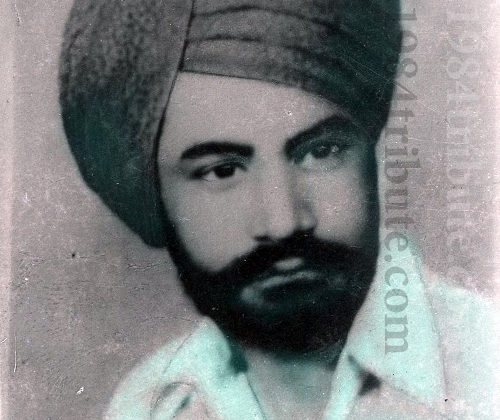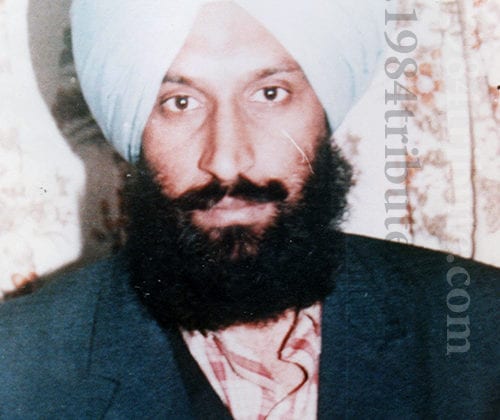Shaheed Bhai Sukhdev Singh Jagga
Shaheed Bhai Sukhdev Singh Jagga
Babbar Khalsa
Bhai Sukhdev Singh Jagga was born in the year of 1951, in the house of Sardar Chanan Singh and from the womb of Mata Karnail Kaur, in the village of Bhullar, which is situated 6 Kilometres from Mukhatsar city. Bhai Sahib was the youngest of 5 brothers and sisters. From his childhood, Bhai Sahib was a keeper of free thinking and a man of honour and good morals. Bhai Sahib studied up to 7th class at the local village school, and after took admission in an academy in Mukhatsar, where he studied up till 10th class. Then Bhai Sahib passed his BA at the Government College of Mukhatsar.
In the year of 1978, as the Sikhs peacefully protested against the sacrilege of Dhan Guru Granth Sahib Ji Maharaj they were shot at by Indian bullets and 13 Singhs attained martyrdom and many more were wounded. This massacre of Sikhs started to make the blood of young Sikhs boil, which previously had gone cold. In one of his speeches after this massacre Sant Jarnail Singh Ji Khalsa Bhindranwala said, “Singho, now is not the time to sleep. Rather than to be killed while peacefully protesting, it would be better to die for taking our rights. We should take this responsibility as individuals instead of waiting for someone to order us.”
Now Bhai Sukhdev Singh Jagga had started to attend the lectures of Sant Jarnail Singh Ji Khalsa Bhindranwale at Sri Manji Sahib. After listening to these informative lectures, a warrior spirit took birth within Bhai Sahib and he started taking part in Jhujaru activities. In June 1984, during the attack on different Gurudwaras around Punjab, Bhai Sahib was at Sri Darbar Sahib in Mukhatsar, from where the Indian army arrested many Sikhs including Bhai Sahib. The arrested Singhs were first brutally tortured in the Parikarma of Sri Darbar Sahib (Mukhatsar). For the whole day the Singhs were made to lay on the Parikarma under the boiling hot weather and then they were taken to the Khalsa School where they faced more torture. After this the Singhs were charged with many cases and sent to Faridkot jail. After spending 14 months in jail, Bhai Sahib was released on bail and he returned home. Bhai Sahib stayed at home for a few days until he located some Jhujaru Singhs and then left to once again start taking part on Jhujaru activities.
In May 1986, an informant had Bhai Sahib arrested from Moga. At first the Punjab police bought Bhai Sahib to Sadar police station in Mukhatsar, where he was tortured for many days and after Bhai Sahib was taken to Siti police station. Even here Bhai Sahib was tortured for many days, but the police could not attain any information from him. After 2 months of blind torture, Bhai Sahib was first sent to Sangrur jail and then transferred to Nabha jail. By the time Bhai Sahib was released in March 1990 on bail, he had spent almost 4 years in Indian jails. Now instead of leaving home and going underground, Bhai Sahib decided to secretly take part in Jhujaru actions while living at home. Bhai Sahib had now also opened a dairy, which was a front for locals. Now people thought Bhai Sahib was busy running his dairy but the truth was that Bhai Sahib was secretly punishing anti-Sikh elements.
During this time, a Sikh woman from the village of Malan was being harassed by in-laws. The woman approached Bhai Sahib and he along with some Jhujaru Singhs visited the in-laws. Bhai Sahib made the in-laws understand that their daughter in-law is someone’s daughter and they wouldn’t want their daughter to be treated like this. Upon a lengthy discussion the in-laws agreed to not harass their daughter in-law but after Bhai Sahib had left the in-laws registered a case against Bhai Sahib to the Mukhatsar police of intimidation, they told the police that Bhai Sahib was still active in Sikh struggle. That evening Bhai Sahib was arrested from home and taken to Sadar police station. For 3 days Bhai Sahib was tortured but once again released on bail after the local Panchayat got involved. Now Bhai Sahib had realised that he can’t carry on doing actions secretly, and so Bhai Sahib said his final farewell to his family and left home. Bhai Sahib joined Babbar Khalsa and committed to fighting for the establishment of Khalistan.
In his Jhujaru life, Bhai Sahib did many Jhujaru actions, but he never took the responsibility of any action in public. Bhai Sahib took percussions to not allow his name to come in the media. Bhai Sahib wasn’t really active in his own area, he preferred to be active in other areas and regularly changed his appearance so no one could recognise him. Bhai Sahib never stayed in one area for too long, he would do an action and then move on to another area where he would change his appearance. Bhai Sahib did not stay with his relatives, in fact he would stay with the further relatives of his own relatives. Bhai Sahib also had one principle that if he could do an action by himself than he would not take a second person. Bhai Sahib believed that taking too many Singhs for an action can jeopardise their lives. Like this Bhai Sahib did many actions in different areas, but the informants of the enemy didn’t manage to realise who was doing these actions.
In the year of 1992, the Indian government had stepped up their injustices to step down the Khalistan movement. The generals of Khalistan were being killed, Bhai Sahib thought it would be better to leave Punjab and carry on his Jhujaru activities in Rajasthan. But police black cats, which were already active in Rajasthan in a big number under the disguise of material wholesalers had recognised Bhai Sahib in the village of Hathian Wala. Bhai Sahib was arrested and taken to the railway station of Mantili Mandi and it was here on 6th March 1993 Bhai Sahib was shot in the head and made a martyr. Bhai Sahib’s body was left on the railway line.
Vangaar – September 1993




